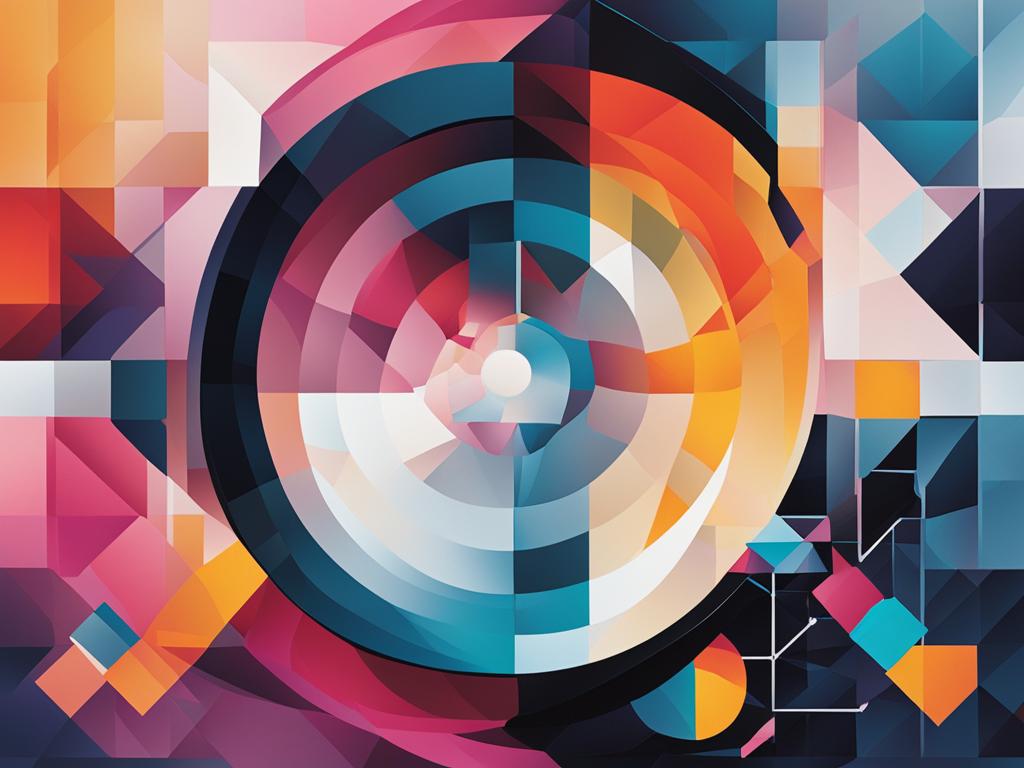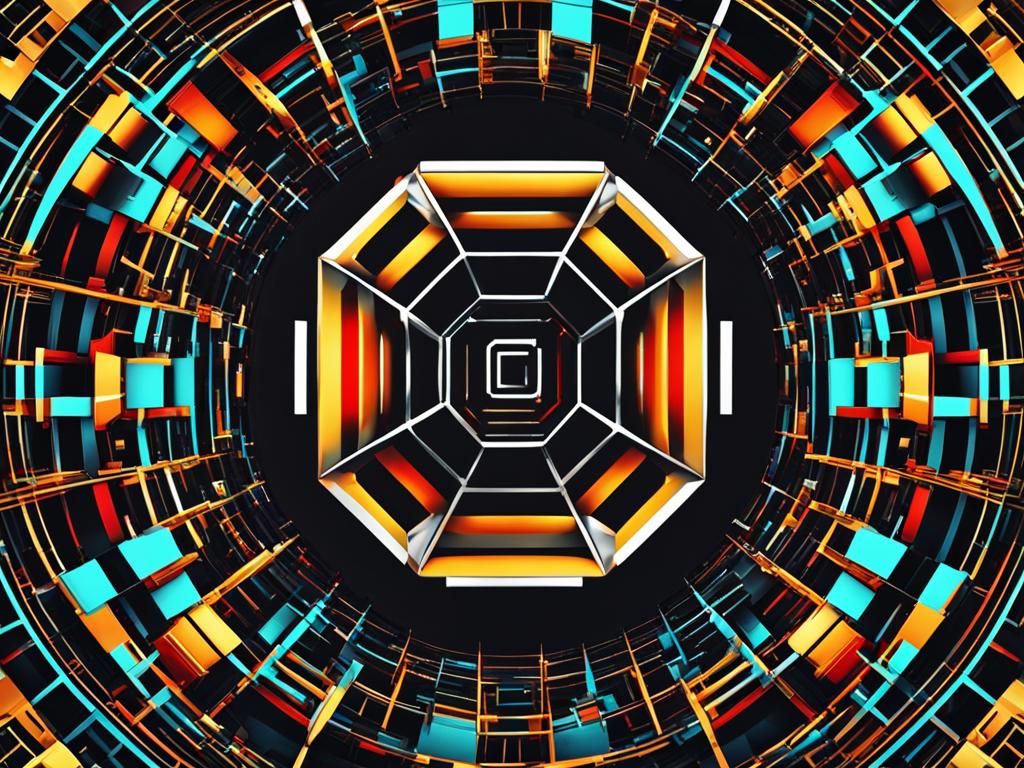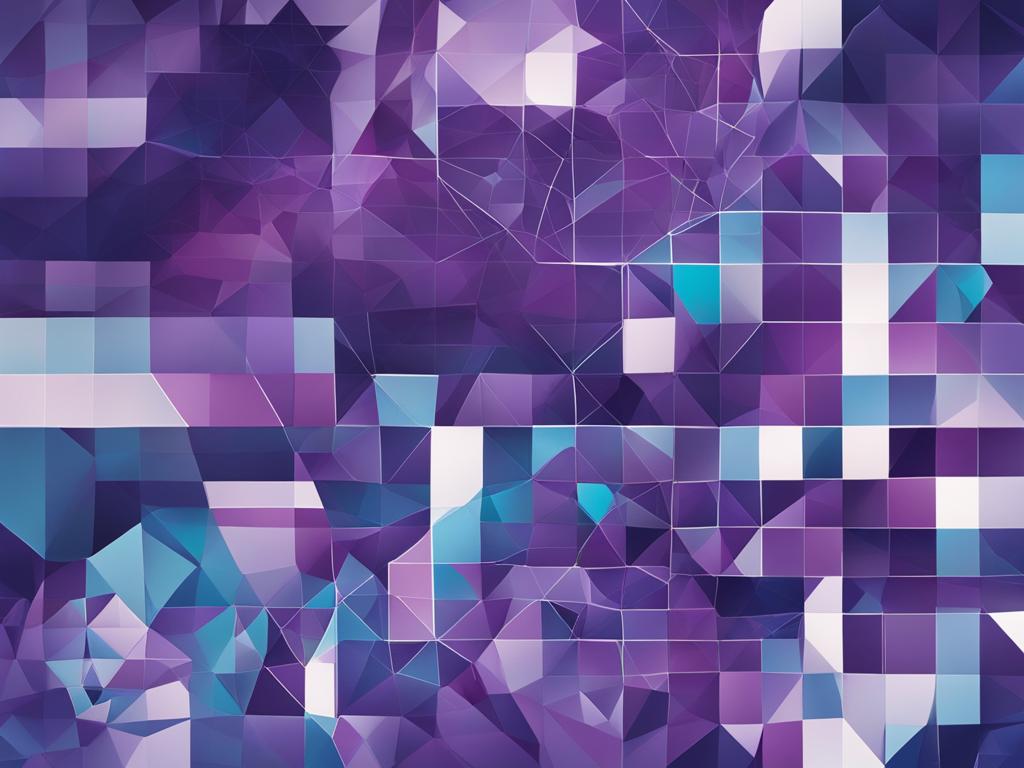Welcome to our latest article, where we delve into the fascinating world of blockchain art. In recent years, the art world has seen a significant rise in the adoption of blockchain technology, particularly in relation to digital blockchain art and NFTs (Non-Fungible Tokens).
In this article, we will explore the impact of blockchain on various aspects of the art industry, including digital art ownership, market trends, and art provenance. We will also discuss the benefits and risks of blockchain art investing and how blockchain is reshaping copyright laws in the art world.
Join us as we provide a comprehensive overview of the latest trends, insights, and analysis of the blockchain art market and how it is changing the way we create, own, and trade digital art. Follow us as we examine the different applications of blockchain technology and its role in transforming the art industry as we know it.

What is Blockchain Art?
Blockchain art refers to works of art that are created, owned, and traded using blockchain technology. Blockchain, which is the technology behind cryptocurrencies such as Bitcoin, allows for secure and transparent transactions without the need for intermediaries.
In the context of art, blockchain allows for the creation of digital art that has provable ownership and authenticity, and cannot be duplicated or replicated without the owner’s permission. Digital blockchain art is commonly referred to as NFTs, which stands for Non-Fungible Tokens. These tokens provide proof of ownership and provenance for works of art, including digital works like videos, images, and audio files.
The significance of blockchain art lies in its ability to provide a transparent and secure method for buying and selling art, eliminating issues of fraud and forgery that have plagued the art market for centuries. It is also transforming how we think about ownership and copyright in the digital age.
“Blockchain technology offers a new way of thinking about ownership and authenticity that can revolutionize the art world.”
Understanding NFTs in Blockchain Art
Non-fungible tokens (NFTs) are digital assets stored on a blockchain that represent ownership of unique items, such as art pieces. NFTs provide a secure and transparent means of buying, selling, and trading digital art. Unlike traditional art pieces, NFTs have a digital identity that can be traced back to their origin, proving their authenticity and ownership.
When NFTs are minted, a copy of the digital asset is recorded on the blockchain, while the original remains with the creator. This process allows collectors to own the original, unique version of an artwork, rather than a reproduction.
The use of NFTs in blockchain art has revolutionized the art market, enabling artists to bypass traditional gatekeepers and sell their pieces directly to collectors. By using NFTs, artists can receive a percentage of each resale of their artwork, providing a new stream of revenue.
“NFTs have disrupted the art world, providing creators with a new avenue for monetizing their work and collectors with a secure means of owning digital assets.”
The Impact of Blockchain on Digital Art Ownership
The rise of digital art has presented new challenges related to ownership and provenance, as digital artworks can be easily replicated and distributed without the artist’s consent. Blockchain technology offers a promising solution to this problem, providing a secure and transparent method for tracking digital art ownership.
With blockchain, digital artworks can be registered as non-fungible tokens (NFTs), which represent a unique and indivisible asset. The ownership and provenance of each NFT are stored on a decentralized ledger, providing a tamper-proof and permanent record of the artwork’s history.
This has significant implications for digital art ownership, as it allows artists to retain control over their creations and ensure that their work is not misrepresented or sold without their consent. Additionally, blockchain technology enables collectors to verify the authenticity of digital artworks and ensure that they are acquiring genuine pieces.
One of the main benefits of blockchain in digital art ownership is the ability to automate transactions and licensing. Smart contracts can be coded onto the blockchain to automatically execute licensing agreements and ensure that artists receive royalties for their work. This helps eliminate the need for intermediaries and streamline the process of buying and selling digital art.
Furthermore, blockchain technology provides an efficient method for conducting provenance analysis, allowing collectors and art historians to trace the ownership history of digital artworks. This enhances the credibility and authenticity of digital art and helps prevent fraud and forgery.
Overall, blockchain technology is transforming the way we approach digital art ownership, providing a new level of transparency and security. As the blockchain art market continues to grow, we can expect to see more innovations and developments in this area.
Blockchain Art Market Trends
Understanding the current trends in the blockchain art market is crucial for both artists and investors. Below, we analyze some of the emerging market trends and their implications:
| Trend | Description |
|---|---|
| New artist platforms | The rise of decentralized artist platforms is creating new opportunities for emerging artists to showcase and sell their work. |
| Increased demand for digital art | Digital art sales have been rising as the demand for art that can be accessed and displayed digitally continues to grow. |
| NFT collectibles | The sale of Non-Fungible Tokens (NFTs) has become a popular means of investing in both physical and digital art. |
| Integration with mainstream art market | The integration of blockchain and traditional art sales is expected to bring more transparency and security to the mainstream art market. |
The market trends in blockchain art are constantly evolving, making it essential to stay up-to-date on the latest developments to stay competitive. With new technologies and opportunities emerging, there has never been a more exciting time to be a part of the blockchain art market.
Reshaping Art Provenance with Blockchain
In the world of art, provenance is a critical component of an artwork’s value, verifying its authenticity and legitimacy. However, traditional provenance systems have often been fallible, with records subject to tampering and manipulation. This is where blockchain technology comes in, providing a transparent and immutable record of artwork history. Blockchain ensures that every transaction is recorded and linked to the previous one, creating an unbreakable chain of ownership and provenance. This means that collectors can be certain about an artwork’s authenticity and ownership, boosting its value and desirability.
Furthermore, blockchain enables more comprehensive and accessible art provenance analysis. It allows anyone, from collectors to art historians, to trace an artwork’s history through multiple linked records. This creates a more detailed and accurate picture of an artwork’s journey, informing its interpretation and contextualization.
“Blockchain technology has revolutionized art provenance analysis, making it more reliable, transparent, and accessible. It’s an important step forward in the art world, providing collectors and art lovers with more confidence and certainty in their transactions and research.”
In summary, blockchain is reshaping the way we approach art provenance, providing a more secure and detailed record of an artwork’s journey. It has the potential to transform the art market, increasing transparency and trust among buyers and sellers.
Blockchain Art and Copyright Laws
In the art world, copyright laws are vital in protecting artists’ rights from plagiarism and unauthorized reproduction of their work. The emergence of blockchain technology has brought new solutions to the challenge of enforcing copyright laws.
As digital blockchain art gains popularity, artists are seeking ways to ensure that their works are not replicated without their consent. With blockchain, artists can protect their copyright and assert their ownership over their creations by recording their artwork’s information on the blockchain network. Any reproduction of the artwork will be traceable to its original source, ensuring that artists receive proper credit, recognition, and compensation for their work.
Blockchain technology enables transparent and immutable smart contracts that establish ownership and hand over licensing rights. These smart contracts ensure that artists’ works are not sold or reproduced without their knowledge or consent, creating a secure system that protects artists’ interests.
Moreover, blockchain technology creates a permanent digital paper trail that can be used to track art ownership and ensure its authenticity. When coupled with advancements in blockchain art provenance analysis, this technology ensures that any dispute regarding ownership or artwork history can be resolved accurately and efficiently.
The use of blockchain in enforcing copyright laws in the art sector is proving to be a game-changer. With blockchain’s immutability and transparency, artists can protect their works and safeguard their rights in perpetuity, while potential buyers can ensure that they are investing in legitimate works of art.

Creating Blockchain Art: A Step-by-Step Guide
Blockchain technology has opened up new possibilities for artists to create, showcase, and sell their artwork. Here, we provide a step-by-step guide for artists interested in creating blockchain art.
Note: Before creating blockchain art, you need to have a basic understanding of cryptocurrency and how blockchain technology works.
Tools for Creating Blockchain Art
These are the tools you need to get started with creating blockchain art:
- A digital art creation tool, such as Adobe Photoshop or Procreate
- A cryptocurrency wallet, such as MetaMask or MyEtherWallet
- A platform for minting and selling your artwork, such as OpenSea, SuperRare, or Nifty Gateway
- Ethereum, the most widely used blockchain for NFTs
Creating and Minting Artwork on the Blockchain
Once you have your tools ready, follow these steps to create and mint your artwork on the blockchain:
- Create your artwork using a digital art creation tool. Keep in mind that your artwork should be unique and have a clear title and description.
- Connect your cryptocurrency wallet to your chosen platform for minting and selling your artwork. Make sure you have enough Ethereum in your wallet to cover the minting fees.
- Mint your artwork on the blockchain. This process involves uploading your artwork to the platform, setting a price, and creating an NFT that represents your artwork on the blockchain.
- Once your artwork is minted, it becomes a unique, one-of-a-kind digital asset that you can sell or trade.
“The ability to create and own a unique piece of art has never been easier or more secure thanks to blockchain technology.”
By creating and minting your artwork on the blockchain, you can ensure its authenticity and provenance, and have full control over its distribution and ownership. Additionally, blockchain art has the potential to appreciate in value over time, making it an attractive investment opportunity.
Now that you have a better understanding of how to create blockchain art, you can start exploring this exciting new world of digital art ownership and investing.
Investing in Blockchain Art
As with any investment, the blockchain art market has its share of risks and rewards. However, investing in this emerging sector can present a unique opportunity for financial gain and portfolio diversification. Blockchain technology provides transparent provenance and ownership tracking, which lends itself well to the art world, particularly with the rise of digital blockchain art and NFTs.
One of the most significant advantages of investing in blockchain art is the potential for exponential growth. The blockchain art market is still in its early stages, and as more collectors and investors enter the space, prices will likely continue to rise. Additionally, investing in blockchain art provides a means of supporting emerging digital artists, allowing them to monetize their work and gain recognition.
However, there are also risks to consider. The value of digital art can be volatile, and there is always the possibility of market fluctuations. Additionally, due to the novel nature of blockchain art, there is a degree of uncertainty regarding its future trajectory and reception by the art world at large.
As an investor in the blockchain art market, it is crucial to approach the process with caution and thorough research. You should analyze the artist’s history and pedigree, examine the blockchain records to ensure authenticity, and study the current market trends. Moreover, you must also consider the legal and regulatory implications of blockchain art investing.
Overall, we believe that investing in blockchain art can be an exciting and profitable opportunity for those willing to navigate the nuances and uncertainties of this emerging sector.
Analyzing Blockchain Art Provenance
In the world of art, provenance refers to the documented history of ownership and origin of a particular artwork. In the realm of blockchain art, recording this history is made easy through the use of blockchain technology and can be analyzed to provide insights into the authenticity and ownership of artworks. By examining the blockchain history of an artwork, we can trace its journey through various owners and transactions, identifying any inconsistencies or discrepancies that may indicate fraudulent activity or unauthorized changes.
Blockchain art provenance analysis is an essential tool for art collectors, investors, and institutions looking to verify the authenticity and ownership of artworks. It provides a transparent and immutable record of an artwork’s history, which can be used to resolve ownership disputes, authenticate artworks, and enhance their market value.
To conduct thorough blockchain art provenance analysis, we can use various tools and techniques, such as:
- Blockchain explorer tools, which allow us to access the blockchain data and track an artwork’s transactions.
- Expert analysis and comparison of an artwork’s physical characteristics, such as materials, style, and techniques, to its recorded history on the blockchain.
- Verification of an artwork’s digital certificate of authenticity (COA) and its corresponding blockchain history.
By utilizing these tools and techniques, we can obtain a detailed and informative analysis of an artwork’s provenance on the blockchain, providing valuable insights into its history and ownership.

The Future of Blockchain Art
As blockchain art continues to gain popularity, the future looks promising for this innovative intersection of technology and art. Emerging technologies such as virtual reality and augmented reality are expected to become increasingly integrated with blockchain art, offering new and immersive experiences for collectors and enthusiasts alike.
Moreover, the use of blockchain in the art industry is expected to expand beyond digital art, with traditional artworks adopting blockchain technology for art provenance and authentication. This is especially pertinent in the wake of recent high-profile art scandals and forgeries, highlighting the need for secure and irrefutable records of artwork history.
With the growing popularity of NFTs (Non-Fungible Tokens) and decentralized platforms for art transactions, blockchain is shaping up to be an increasingly essential tool for artists, collectors, and enthusiasts. The future of blockchain art promises to be dynamic and transformative, with endless possibilities for new technologies and innovations.
“Blockchain technology is poised to disrupt the art world in a major way, offering irrefutable proof of provenance, simplified fractional ownership, and greater transparency in transactions.”
Conclusion
In conclusion, we have explored the world of blockchain art and its impact on the art industry. From NFTs to digital art ownership, we have discussed how blockchain technology is revolutionizing the art world, providing transparency, immutability, and authenticity to art transactions.
As we continue to witness the growth and emergence of decentralized art platforms and the expansion of the blockchain art market, we are excited about the future of blockchain art. The potential for blockchain to transform art provenance and copyright laws is immense, paving the way for greater protection of artists’ rights and the prevention of plagiarism.
Whether you are an artist, collector, or investor, blockchain art presents a unique opportunity to explore new avenues in the art world. Through this article, we hope to have provided you with valuable insights and trends to navigate the exciting world of blockchain art.
Thank you for joining us on this exploration of blockchain art, and we look forward to the future developments and innovations that lie ahead.
